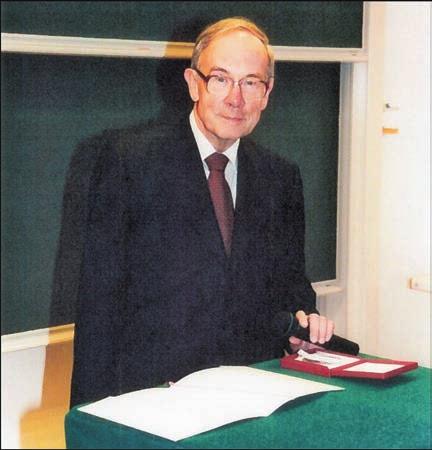by Mina Teicher
I want to start with the day that Hirzebruch received the Wolf Prize. It was on May 12, 1988, in the Knesset (the parliament) of Israel in Jerusalem — a very structured ceremony in the presence of the president of the country and five hundred guests. Hirzebruch was sixty years old at the time he was awarded the Wolf Prize. He was the youngest person and only the second German to have received it.
Two prizes in mathematics were awarded, and Hirzebruch was chosen to respond on behalf of himself and the other laureate. He came to the podium to deliver his speech. With his strong and direct voice, he expressed his gratitude to the Wolf Foundation for awarding them the prize. He then added a few sentences on behalf of himself only. When he completed his speech, the audience was dead silent for a few seconds, and then with tears in their eyes they started to clap in a fashion that is usually not seen in the academic world. They clapped and clapped more and more. He had spoken from his heart and had exposed his soul:
[…] As a professor at the University of Bonn, I am one of the successors of the famous mathematicians Felix Hausdorff and Otto Toeplitz. Hausdorff committed suicide in 1942, together with his wife, when deportation to a concentration camp was imminent; Toeplitz emigrated to Israel in 1939 and died there the following year. The memory of these mathematicians is with me always on this trip.
In these three sentences he managed to create continuity between the mathematical community in Bonn before and after the Nazis, to establish links between the Jews in Germany and the Israeli society, and to penetrate the hearts of the listeners.

Hirzebruch’s first visit to Israel was in 1981 by the invitation of Piatetski-Shapiro, my Ph.D. advisor at the time. He was widely welcomed for being the great mathematician he was, as well as for his leadership role in reestablishing mathematics in Europe after WWII. But it was only in the late 1980s that he started to be actively involved in the mathematical research infrastructure in Israel.
Hirzebruch had a fundamental role in the Emmy Noether Institute of Bar-Ilan University. Following his advice, we prepared an application for a joint German-Israeli Minerva center in mathematics. We named the center after one of the greatest scientists of the twentieth century and one of the first female mathematicians, the German-Jewish mathematician (who fled to the USA in the early 1930s) Emmy Noether. The application was submitted to the Minerva Foundation (a subsidiary of the Max Planck Society), and in 1991 it was approved.
The inauguration ceremony of the Emmy Noether Institute took place in the house of the Israeli ambassador in Bonn in July 1992. A binational Beirat was appointed by the Bar-Ilan University and the BMBF. Hirzebruch was appointed by the deputy minister of the BMBF as the chairman of the Beirat. He served as chairman for twelve years, a role he took on with great commitment. He contributed his valuable time (when appointed he was still the director of MPIM in Bonn), his endless energy, his deep wisdom, and his vast experience to the success of the center. In 2000 he received an honorary degree from BIU for his contributions.
Two major conferences in algebraic geometry were held in the center in his honor. “Hirz 65” was held in May 1993 and attracted an international audience, including Fields medalists, directors of research institutes worldwide, collaborators, former students — all came to pay respect. “Hirz 80” was held in May 2008 and was one of the last big conferences he attended. Again, five Fields medalists attended, four Wolf Prize winners, and more. Fritz came, accompanied by his wife, Inge, and his son, Michael. He was very pleased to meet old friends, attended ALL the talks, and enjoyed the celebrations and the tours to the Golan Heights and Jerusalem. Unfortunately, on the day before the last, during a tour in the Western Wall caves, he fell and broke his leg, but then was most concerned that the conference was continuing as planned and kept apologizing for disturbing the agenda!
I was reflecting on the times (circa 1975) when, for me, the name Hirzebruch was the title of a yellow book Topological Methods in Algebraic Geometry, which, as part of my M.Sc. studies, I had to read and then give a shorter proof of the Hirzebruch–Riemann–Roch Theorem in the special case \( n = 3 \). In spring 1988 I participated in a special semester in Bonn on algebraic surfaces, coorganized by Hirzebruch. Ten years later, in summer 1998, we organized together a special semester in the MPI, “Topology of Algebraic Varieties”. He gave brilliant lectures, presenting complex geometrical structures in a simple and natural way, demonstrating beautiful examples. I learned more about the skills that helped him reestablish the mathematical community in Europe after the war. He never forgot that mathematics is made of — and by — mathematicians. Listening and attending to everybody’s needs, “combining” people, making his own friends into friends of one another. A man who followed his values with no exception. A noble man.